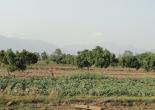- Skip to main content
- Skip to navigation
- Screen Reader Access
- Text Size
- Select Theme Default Theme Yellow Theme Pink Theme Blue Theme
- हिंदी में
- Home
- STATE PROFILE
State Profile
Uttarakhand, located at the foothills of the Himalayas, is characterized by diverse geographical features ranging from snow-capped mountain peaks in the North to tropical forests in the South. It has been divided into two regions- the western region- Garhwal Mandal and the eastern region- Kumaon Mandal. It is divided into 13 districts which consist of 95 blocks. The table below gives key demographic indicators and their comparison with pan-India numbers-
|
SN |
Indicators |
Unit |
Uttarakhand |
India |
|
1 |
Geographical Area |
Lakh Sq. Km |
0.53 |
32.87 |
|
2 |
Population |
Crore |
1.01 |
121.02 |
|
3 |
Decadal Growth Rate |
Percentage |
19.17 |
17.64 |
|
4 |
Density of Population |
Population/Sq. Km. |
189 |
382 |
|
5 |
Urban to Total Population |
Percentage |
30.49 |
31.16 |
|
6 |
Sex Ratio |
Females/1000 Males |
963 |
940 |
|
7 |
Literacy Rate (LR) |
Percentage |
79.60 |
74.04 |
2. Land Use
Out of a total geographical area of 5.35 million ha in the state, 4.6 million ha (86%) is hilly area and 0.74 million ha (14%) is plain area. Only about 14 percent of the geographical area is cultivable which is mainly attributed to the topography of the state. Because of its location and diverse climate, the State has certain unique advantages for development of horticulture, agro processing industries, organic farming, off season vegetable cultivation and cultivation of medicinal and aromatic plants which can be gainfully exploited. Similarly, service sector, particularly tourism offers a large potential for employment generation in both urban and rural areas. The State is having about 61.1% area under forests. The share of net sown area is only about 14 % as against the national average of 43.37%. The share of culturable wasteland is about 7% which provides a huge potential for fodder trees and other plantation crops including fruits.
Agriculture is a predominant sector in the state economy which contributes around 23.4% in State Domestic Product (GDP).The average size of land holding in the state is 0.95 ha (Marginal-0.39, Small-1.38, Medium-3.33 and Large-36.00) as against the National Average of 1.57 ha. The share of small and marginal holdings is higher in Uttarakhand State as compared to National Average. The agriculture sector in the state continues to remain heavily depended on rainfall. The net Irrigated area in the State is 3.45 lakh ha. Out of which 85.83% is in plains and 14.17% are is in hills. The irrigation intensity in the State is 159% which varies between 155% in plains to 184% in hilly region.
3. Agro Climatic Zones
The state has different agro-climatic conditions, slopes and height. Details of Physiographic Zones and farming situations in the state are as under:
|
S.N |
Zone |
Farming situation |
Soil |
Rainfall (mm/year) |
Districts |
Principal farm produces and Livestock |
|
1 |
Zone A up to 1000 M |
Tarai irrigated |
Alluvial |
1400 |
U.S. Nagar, Haridwar |
Rice, wheat, sugarcane, lentil, chickpea, rapeseed mustard, mango, Litchi, guava, peach and plums. Livestock: Buffalo and cattle |
|
Bhabar Irrigated |
Alluvial mixed with boulders and shingles |
1400 |
Nainital, Dehradun and Pauri Garhwal |
Rice, wheat, sugarcane, rapeseed mustard, potato, lentil, mango, guava and litchi. Livestock: Buffalo and cattle |
||
|
Irrigated lower hills (600-1000M) |
Alluvial sandy soil |
2000-2400 |
Champawat, Pauri Garhwal, Dehradun, Nainital, Tehri Garhwal |
Rice, Wheat, onion, chilly, peas, potato, radish, cauliflower, pulses, oilseeds, soybean, mango, guava, plums and peaches. Livestock: Buffalo and cattle |
||
|
Rain-fed lower hills (600-1000M) |
Residual sandy loam |
2000-2400 |
Champawat, Nainital, Pauri Garhwal, Dehradun, Tehri Garhwal, Bageshwar |
finger millet, Maize, rice, wheat, pulses, mango, guava, plums and peaches. Livestock: Buffalo, cattle and goat |
||
|
2. |
Zone B 1000-1500M |
Mid hills south aspect (1000-1500 M) |
Sandy loam |
1200-1300 |
Champawat, Nainital, Almora, Dehradun, Tehri Garhwal, Bageshwar |
Rice, finger millet, wheat, potato, tomato, peas, cole crops, pulses, peach and plums. Livestock: Cattle, sheep & goat |
|
3 |
Zone C 1500-2400M |
High hills (1500-2400 M) |
Red to dark |
1200-2500 |
Pithoragarh, Almora, Chamoli, Bageshwar |
Amaranth, finger millet, French-beans, Cole crops, potato, peas, peaches, plums, pear, apple and stone fruits. Livestock: Cattle, sheep and goat |
|
4. |
Zone D> 2400 M |
Very High hills |
Red to dark Black clay |
1300 |
Pithoragarh, Chamoli and Uttarkashi |
Amaranth, buckwheat, peas, Cole crops, apple and potato. Livestock: Sheep & goat |
Key Links
http://www.doiuk.org/ (Department of Industries, Uttarakhand)
http://agriculture.uk.gov.in/ (Department of Agriculture, Uttarakhand)
http://ukmandi.co.in/ (Uttarakhand Krishi Utpadan Mandi Parisad)
http://uk.gov.in/contents/view/1/6/ (Directorate of Food Processing)
http://www.sidcul.com/ State Infrastructure and Industrial Development Corporation of Uttarakhand Limited (SIDCUL)
http://des.uk.gov.in/ (Department of Economics and Statistics, Uttarakhand)
http://www.ahduk.org/ (Department of Animal Husbandary, Uttarakhand)
http://www.mpstateagro.nic.in/EZ.HTM (agro industries related information)
http://nhb.gov.in/ and http://agricoop.nic.in/ (for all horti and agri production information)






